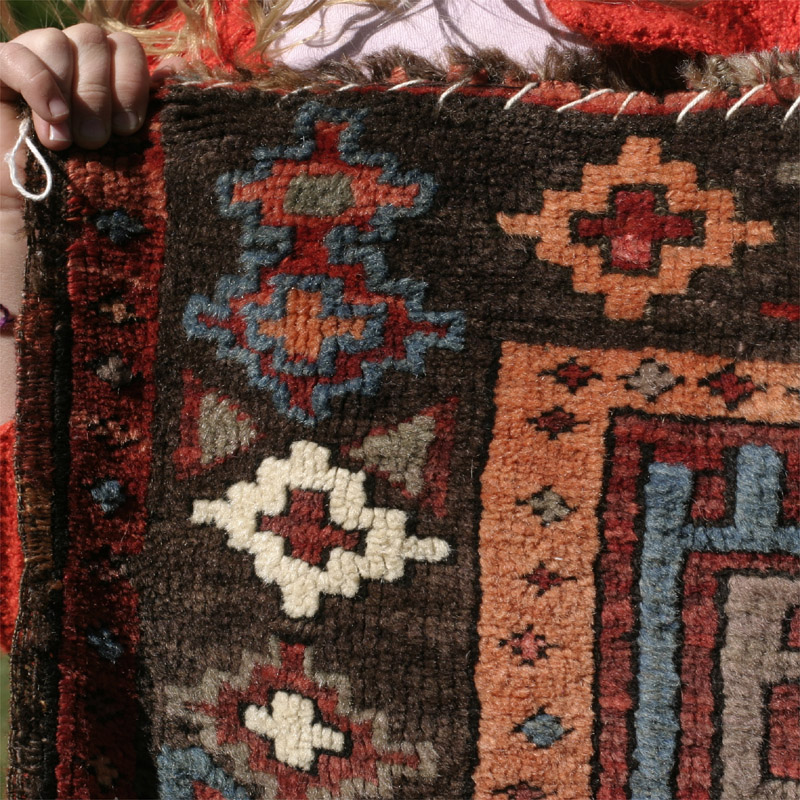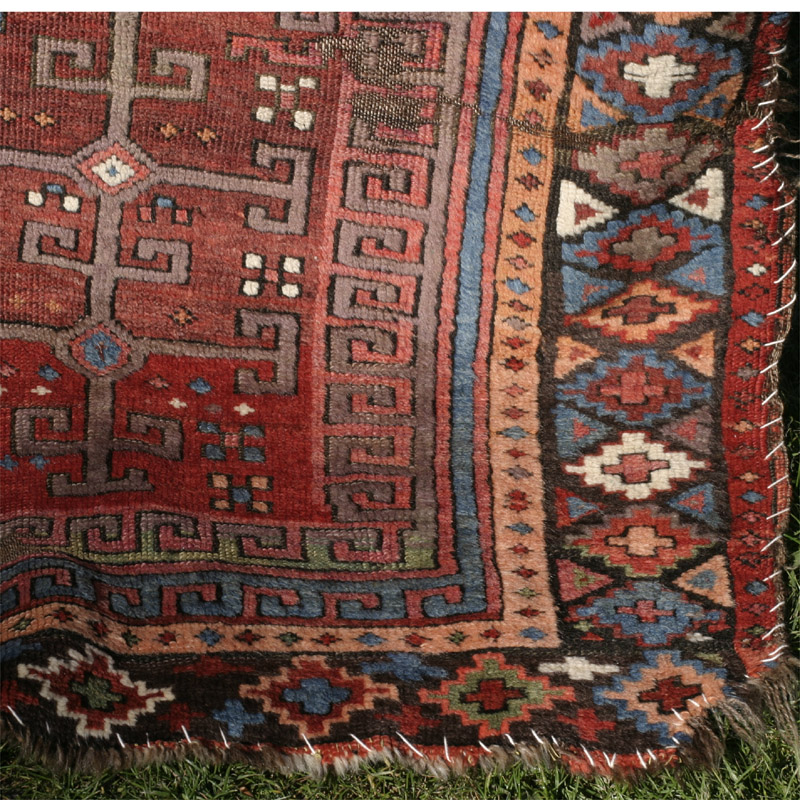Click on image to view at larger size
Click here to see image in extra large size (warning: large image!!, 1.5 MB).
This is a very rare and beautiful central Anatolian tribal prayer rug from around the mid 19th century. The field is taken by an angular tree with horizontally extending branches that end in symmetical angular hooks, with smaller pairs of upwardly bent hooks as secondary branches. In the area where the tree's main branches are rooted the stem widens and encloses small diamonds. A hooked meander line in a light shade of auberine, green at the bottom (2 knot's width, with a one knot wide dark brown outline) runs all around the tree. It is studded by upwards-curling angular hooks at its inside, framing the tree and like it, floating on the madder-red abrashed field. Small geometric filler elements surround the tree. A simple triangular mirhab extends diagonally from both sides of the inner meander line, to meet at the top in an arrow-like shape. Just above, another narrower white hooked meander line floats on the red field to frame the mirhab as if to protect it at top and sides. Further out, there is a further medium blue meander line with hooks merely at top and bottom; then a a simple border of small diamonds on a beautiful madder-based apricot ground. All this is then enclosed by the main border, which on dark brown ground shows a simple but very effective row of stepped diamonds in beautifully saturated colours, an excellent green among them (only in the bottom part; the weaver must have then run out of green wool).
Some people may be prone to interpret a totemistic meaning into the central tree. I usually prefer more mundane explanations, but no one knows for sure about the origin of the design (enlighten me if you know more). James Opie's animal head columns theory comes to mind but none of the rugs in his book Tribal rugs (least those in the Anatolian section) is close to the example here. There was a long discussion on Turkotek a while back that I have put up here. This thread contains some examples of other rugs with similar borders, the second of them, labelled Yatak, with the same type of hooks in the field. Apart form these examples provided by Sonny, I have not found similar examples in my admittedly limited rug library.
Both dyes and design suggest considerable age, probably around the mid 19th century, maybe earlier. According to Sonny Berntsson of AKREP, Gothenburg, who may be the best living expert on antique Turkish rugs, the rug is probably from the mountain area Karacadag ('black-looking mountain'), 20 km north of Karapinar. Sonny states it has a colour palette and design that was typical for Emirgazi area more than hundred years ago. "Their own rugs, yataks, divan rugs and yastiks had dark, deep colours, but very bright, in red-brown madder, apricot, green, aubergine, and often brown/black colour in the main border. But not so much blue. Their pattern are always strictly geometric and with hooks like meander-hooks as a frame around the centre." According to Sonny the rug was probably woven by Tukmen Yöruks (see thread pointed to above), others think of the design as Kurdish. I simply don't know.
Please compare a long Turkotek thread about the colour and origin of this rug that I have re-published here.
The prayer rug measures 3ft.9in. x 3ft. (117cm x 96cm). As would be obvious for a rug of this type and age, foundaton and pile are all wool. The weave is not depressed (all warps in the same layer), the knotting symmetrical (Turkish knot). The warps (2 strands S-plied) are of various shades of light to dark brown wool. There are between 2 and 4 thin dark brown weft shoots after each row of knots (mostly just two). The pile wool is long staple, excellent, and very lustrous, The weave is coarse: 24h/dm x 27v/dm = 648 square dm (or 6h/in x 7v/in = ca. 42 kpsi). The handle is meaty, soft and supple.
The palette is limited but beautiful, based on all natural dyes (the Turkotek discussion removed the last suspicions I harboured regarding the pale aubergine dye of the inmost meander line). At the likely time when this rug was made, synthetic dyes were simply not yet used at all. Cochenille was beginning to be used from the 1850-60s, later quite extensively especially in Eastern Anatolia, where it was apparently easier to obtain than madder. The various shades of red as well as the apricot and pink in this rug look all madder-based (probably also the pale aubergine). Then there is a clear white, a medium indigo blue, a brillant green, and dark brown, maybe natural brown wool, but, given the slight corrosion, probably overdyed with an iron mordant—perhaps oak or gallnut.
The pile is mostly good( 8-9 mm long near in the main border, prgressively shorter towards the centre, down to knot heads in the very centre). Dark brown pile in the main border is a little bit corroded in places. The sides and ends are evidently damaged (see images) to a point where a repair would probably do unjustice to this ethnographic textile. The sides and ends are being secured right now in a very coarse manner—I liked the improvised style and the big stitches but I can imagine most collectors would probably want to mount this rug on a cloth or secure the sides in a less obvious manner. It is evident that this rug has been used for its intended purpose—the places where knees and feet rest during prayer are bare to some extent (again, see images). The foundation however is sound, and there are no holes, cuts or tears. The rug is clean and has no odour. I have no idea whether or when it has ben washed but this seems quite unnecessary.







